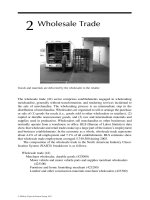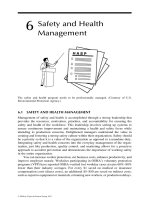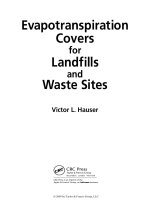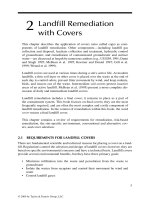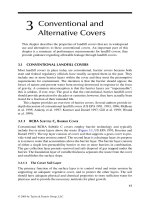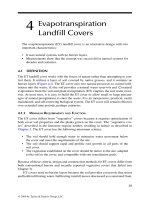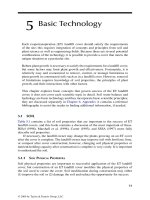Evapotranspiration covers for landfills and waste sites - Chapter 2 docx
Bạn đang xem bản rút gọn của tài liệu. Xem và tải ngay bản đầy đủ của tài liệu tại đây (197.11 KB, 7 trang )
7
2
Landfill Remediation
with Covers
This chapter describes the application of covers (also called caps) as com-
ponents of landll remediation. Other components—including landll gas
collection and disposal, leachate collection and treatment, hydraulic control
of groundwater, and remediation of contaminated groundwater and surface
water—are discussed at length by numerous authors (e.g., US EPA 1991; Dunn
and Singh 1995; McBean et al. 1995; Koerner and Daniel 1997; Gill et al.
1999; Weand et al. 1999).
Landll covers are used at various times during a site’s active life. At modern
landlls, a thin soil layer or other cover is placed over the waste at the end of
each day to control odors, prevent litter movement by wind, and keep rodents,
birds, and insects out of the waste. Intermediate soil covers protect inactive
areas of an active landll. McBean et al. (1995) present a more complete dis-
cussion of daily and intermediate landll covers.
Landll remediation includes a nal cover; it remains in place as a part of
the containment system. This book focuses on nal covers; they are the most
frequently required, and are often the most complex and costly component of
landll remediation. In the context of remediation within this book, the word
cover means a nal landll cover.
This chapter contains a review of requirements for remediation, risk-based
remediation, the site-specic environment, conventional and alternative cov-
ers, and cover selection.
2.1 requirements for lanDfill Covers
There are fundamental scientic and technical reasons for placing a cover on a land-
ll. Regulations control the selection and design of landll covers; however, they are
based on specic environmental concerns and have a technical basis. Landll covers
provide several environmental benets, but they have three primary goals:
Minimize inltration into the waste and percolation from the waste to •
groundwater
Isolate the wastes from receptors and control their movement by wind and •
water
Control landll gases•
© 2009 by Taylor & Francis Group, LLC
8 Evapotranspiration Covers for Landfills and Waste Sites
These three goals are common to all landll cover designs; their implementation
may include conventional covers based on regulatory requirements. However, alter-
native landll covers also satisfy these goals and may provide a more protective,
longer-lasting, and less costly solution.
Landll covers are intended to remain in place and protect the environment
for an extended period, perhaps centuries; therefore, they should be durable and
self-renewing. Landll covers should satisfactorily control inltration of precipita-
tion into the waste because it has potential to carry soluble wastes downward to
groundwater. Covers that meet the inltration requirement usually satisfy the second
requirement, that is, that the waste should be isolated from receptors and its move-
ment controlled.
Gas collection may be required to dispose of explosive and toxic landll gas
generated by the biodegradation of organic matter and other chemicals in the waste.
This is especially true for landlls with covers that include barrier layers because
they trap and accumulate gas; thus, they usually need gas collection and disposal
systems. The long-term operation and maintenance of an active or passive gas col-
lection and disposal system, if required, are signicant nancial burdens for the
landll owner.
The migration of landll leachate into an aquifer is important because it may
cause signicant groundwater contamination and the need for expensive remedia-
tion. However, recent work demonstrates that natural attenuation may control the
extent of groundwater contamination caused by some contaminants. Leachate from
a landll that enters the groundwater contains organic material; it, in turn, produces
anaerobic conditions in the groundwater under and down gradient from the landll.
The anaerobic groundwater conditions degraded important contaminants. Therefore,
controlled leaching of landll waste may be benecial in some cases (Hicks et al.
2002), altering the requirement to minimize inltration to groundwater. In any case,
it is necessary to control leachate to meet site requirements.
2.2 risk-BaseD/performanCe-BaseD remeDiation
Previously, regulatory preference for use of design parameters contained in regula-
tions limited or precluded the application of alternative landll covers and designs for
landll remediation. Currently, the regulatory control of landll covers is changing
to allow consideration of alternative technologies. Risk-Based/Performance-Based
(RB/PB) evaluation of landlls is a process that applies engineering and science to
the selection among remediation alternatives and allows better decisions. There is
already a strong regulatory basis for this process, and it is in use for other types of
remediation efforts (Gill et al. 1999).
An RB/PB landll evaluation is a technical approach to selection of protec-
tive remedial options based on the specic conditions at a landll. Using an RB/PB
evaluation allows the landll owner to determine the technical performance require-
ments for a cover at a particular site.
© 2009 by Taylor & Francis Group, LLC
Landfill Remediation with Covers 9
The RB/PB landll evaluation process follows four well-dened steps:
1. Identify releases: On the basis of known waste materials and environmental
sampling, identify the actual and potential releases associated with a par-
ticular landll, including
Surface materials•
Gas generation•
Leachate production•
Groundwater and surface water contamination•
2. Assess exposure: Determine the exposure pathways to potential receptors, and
whether the pathway is complete for each actual or potential release, including
Direct contact•
Airborne contamination•
Surface or groundwater contamination•
3. Assess risk: Estimate the risks associated with each completed source–
pathway–receptor combination.
4. Establish site-specic performance requirements: Determine the specic
performance requirements for each action needed to address the risks iden-
tied, including
Cover requirements to eliminate direct contact•
Required control of inltration to adequately control risks from poten-•
tial leachate
Collection and treatment of gas, if necessary•
Control of groundwater contamination•
No further action if no signicant risks were identied•
The landll owner may use any landll remediation method, including alternative
covers, which meets the performance requirements after they are fully accepted.
This process allows the owner to select the most technically sound and cost-effective
landll remediation for a particular landll.
2.3 faCtors that influenCe remeDiation
Both selection of cover type and its design are dependent on specic site character-
istics. Site characteristics that have a dominant inuence on covers include climate,
soils and plants, landll characteristics, hydrogeology, gas production, seismic envi-
ronment, and reuse of landll areas.
2.3.1 cl I m a t e
Precipitation (rain, snow, and sleet), solar radiation, air temperature, wind, and rela-
tive humidity are the main climatic factors that affect landll covers. Precipitation
amount and distribution in time has a direct bearing on inltration of water into the
cover and, potentially, into the buried waste. Climatic factors inuence ET, which
controls soil water content and percolation through the cover soil. Climate may also
inuence moisture content and temperature of the waste, which in turn controls
© 2009 by Taylor & Francis Group, LLC
10 Evapotranspiration Covers for Landfills and Waste Sites
waste degradation rate. Climatic factors that control soil erosion include precipita-
tion amount and intensity, as well as wind.
The commonly reported annual or monthly averages of climatic variables do
not provide sufcient information with which to evaluate a site. Daily and seasonal
climatic variation controls daily amounts of deep percolation into the waste. For
example, if the majority of precipitation falls during the season when vegetation is
dormant, the potential for inltration through the cover is greater than if the pre-
cipitation falls during seasons of active plant growth. A rainy day following a rainy
day is more likely to produce water movement through the cover than a rainy day
following a dry day.
There is a strong inuence from daily or even hourly climatic patterns, for example,
Precipitation during one or two cloudy and cool days may result in greater •
inltration potential than the same total amount of precipitation spread over
several days with periods of ET interspersed between the rain events.
A single, relatively small rainfall event during or immediately following snow-•
melt when vegetation is dormant has the potential to cause deep percolation.
2.3.2 la n d f I l l a n d Wa S t e ch a r a c t e r I S t I c S
The operating history, wastes, and physical construction of the landll all affect the
remediation options that may be used. For example, some of the characteristics that
affect cover design include the type of waste deposited, whether or not the landll
has a liner, the age of the landll, whether the landll is active or inactive, and the
amount of leachate produced by the waste.
The type of wastes disposed in a landll leads to its classication as (1) municipal
(consisting of typical household wastes), (2) hazardous, (3) radioactive, or (4) mixed
waste (nonradioactive mixed with radioactive). The waste classication directly affects
the cover design because of both the technical and the regulatory requirements.
As a landll ages, the degradation of the waste and the pressure of overlying
materials lead to compression and settling of the waste, sometimes by as much as
33% (Suter et al. 1993; Sharma and Anirban 2007). Landll subsidence is likely to
be severe for landlls containing deep deposits of fresh waste. The resulting subsid-
ence of the overlying cover can cause cracks in clay barriers, separation of geomem-
branes (GMs), and slope changes that adversely affect surface water drainage and
erosion. Landlls that are old, when covered, are less likely to experience excessive
surface subsidence.
2.3.3 hy d r o g e o l o g y
The distance between the bottom of a landll and the water table is an important
determinant of the probability that groundwater has been or may be contaminated.
If the landll has no liner but rests on impermeable bedrock, shale, or clay located
above the water table, or if the depth to groundwater is great, then an unlined land-
ll may pose little threat to groundwater. If waste is in contact with groundwater, a
surface cover cannot provide a complete remedial solution for the site. The quality
and quantity of native groundwater at the site are important because they control
© 2009 by Taylor & Francis Group, LLC
Landfill Remediation with Covers 11
potential use and thus potential need for protection from contamination. Therefore,
the geology of the site and the lithology of geologic units between the waste and
permanent groundwater are important considerations.
2.3.4 ga S Pr o d u c t I o n
Decay of wastes and volatilization of waste components in landlls may produce
sufcient toxic and explosive landll gas to warrant gas control systems under the
cover. Most conventional, barrier-layer covers need an expensive gas control system
because the barrier may trap the gas produced, even at low rates, and may accumu-
late dangerous volumes of explosive or poisonous gas. Innovative covers, such as the
ET cover, contain no barriers that might collect gas. They allow landll gas to pass
through the cover soil into the atmosphere.
Although gas production in a landll can continue for a long time, high rates
occur over relatively short periods, perhaps up to 10 years after the landll becomes
inactive (McBean et al. 1995). Old landlls with no cover in place for 20 years or
more may not need the expense of a gas collection system when covered. For exam-
ple, a survey of less than half of all Air Force landlls revealed that 144 landlls
were both inactive for more than 20 years and not remediated in 1998–1999 (Hauser
et al. 1999); they are unlikely to produce signicant amounts of gas.
2.3.5 So I l S a n d Pl a n t S
The availability of appropriate local soils is an important consideration in any land-
ll design. Conventional covers need local soils for both the foundation and the sur-
face layers. The soil used in an ET cover should meet the requirements for the site
and support robust vegetative growth. For example, ET covers may be impractical
where readily available soils have inadequate water-holding capacity.
The growth habits and properties of plants native to the site are important con-
siderations. For example, in some regions, only warm season grasses are practical
for use on covers, but in others, it is possible to establish both warm and cool season
grasses together on the cover. The combination of warm and cool season grasses is
usually more effective than single-season covers because the combination extends
the time with signicant plant transpiration.
2.3.6 Se I S m I c en v I r o n m e n t
Earthquakes are a signicant threat to public safety and structures. The ground shak-
ing associated with earthquake activity has potential to damage landll containment
structures in many ways, including landslides on the cover, rupture of geomembrane-
barrier layers, cracking of clay-barrier layers, breakage of conduit lines (gas control
and drainage systems, electrical controls, etc.), and changes in drainage slopes.
Matasovic et al. (1998) studied the performance of landll covers and liners dur-
ing six major earthquakes in California between 1969 and 1994. Cover performance
was good to excellent at all of the landlls, with the damage limited to cracking of
cover soils. Within seismic hazard zones, landll designs should be evaluated using
© 2009 by Taylor & Francis Group, LLC
12 Evapotranspiration Covers for Landfills and Waste Sites
site-specic seismic risk assessment criteria. Richardson and Kavazanjian (1995)
wrote an extensive treatment of this aspect of landll design.
2.3.7 re u S e o f la n d f I l l ar e a S
Land reuse is an important consideration in landll cover selection and design. Land-
lls are warehouses for waste material built to preserve waste for an unknown length
of time; that basic requirement controls possible reuse of landll sites. All alter-
nate uses for a landll site are secondary to the primary use for waste preservation.
Human activity on a nal landll cover is potentially dangerous, creates the need for
careful design, and may result in large cost to reduce potential injury to people.
Some apparently benecial uses may conict with primary cover purposes. For
example, irrigation on golf courses causes deep percolation of water below the plant-
rooting zone. Golf courses on landll covers pose immediate problems because one
of the principal objectives of a landll cover—to minimize inltration—probably
cannot be achieved under normal golf course irrigation (Hauser et al. 2000).
2.4 Cover seleCtion
Previously, because federal landll regulations contained design requirements,
almost all landll covers were barrier-type because they met the requirements of the
regulators. However, as stated in Section 1.4, the situation has changed and it is now
practical to utilize the landll cover technology that is most appropriate for a partic-
ular site. Both federal and state regulators currently support alternative technologies
(ITRC 2003; US EPA 2003). An RB/PB landll evaluation, as described in Section
2.2, allows application of the best engineering and science knowledge to select the
most appropriate cover type for a particular site. Where an alternative cover is appro-
priate, it may provide longer and more effective containment than previously used
barrier covers, and save millions of dollars in construction and maintenance cost.
The following 10-step process is applicable to the closure of all landlls. It may be
iterative, and each step may have signicantly different emphasis at a particular site.
1. Determine risks at the specic landll using RB/PB methods (Section 2.2).
2. Determine site-specic performance requirements dictated by the risks at
the site.
3. Select the most appropriate conventional or alternative technologies.
4. Elicit wide regulatory and public participation.
5. Present the proposed technology to the Remedial Advisory Board and
the public.
6. Complete any required modeling, design criteria, and feasibility testing.
7. Conduct peer reviews of the decision process and remediation design.
8. Formally document the selection of the technologies in the record of deci-
sion document (ROD).
9. Complete the design and monitoring plan.
10. Construct all of the remediation components and gather monitoring and
performance data.
© 2009 by Taylor & Francis Group, LLC
Landfill Remediation with Covers 13
referenCes
Dunn, R. J. and Singh, U. P., Eds. (1995). Landll Closures Environmental Protection and
Land Recovery. Geotechnical Special Publication No. 53, ASCE, Reston, VA.
Gill, M. D., Hauser, V. L., Horin, J. D., Weand, B. L., and Casagrande, D. J. (1999). Landll Reme-
diation Project Manager’s Handbook. The Air Force Center for Environmental Excellence
(AFCEE), Brooks City Base, San Antonio, TX. />techtrans/landllcovers/LandllProtocols.asp (accessed March 14, 2008).
Hauser, V. L., Gimon, D. M., Hadden, D. E., and Weand, B. L. (1999). Survey of Air Force
Landlls: Their Characteristics, and Remediation Strategies. The Air Force Center for
Environmental Excellence (AFCEE), Brooks City Base, San Antonio, TX. http://www.
afcee.brooks.af.mil/products/techtrans/landllcovers/LandllProtocols.asp (accessed
March 14, 2008).
Hauser, V. L., Gimon, D. M., and Jackson, D. R. (2000). Golf Courses on Air Force Land-
lls. The Air Force Center for Environmental Excellence (AFCEE), Brooks City Base,
San Antonio, TX. />LandllProtocols.asp (accessed March 14, 2008).
Hicks, J., Downey, D., Pohland, F., and McCray, J. (2002). Impact of landll closure designs
on long-term natural attenuation of chlorinated hydrocarbons. Parsons Corporation,
1700 Broadway, Suite 900 Denver, CO 80290. (Final report to, Environmental Security
Technology Certication Program, Arlington, VA, contract no. DACA72-00-C-0013.)
Also available at: />LandllProtocols.asp (accessed March 14, 2008).
ITRC (2003). Technical and Regulatory Guidance for Design, Installation, and Monitor-
ing of Alternative Final Landll Covers. Interstate Technology & Regulatory Council,
444 Capitol St., NW, Suite 445, Washington, DC 20001. Also available at: http://www.
itrcweb.org/homepage.asp (accessed March 14, 2008).
Koerner, R. M. and Daniel, D. E. (1997). Final Covers for Solid Waste Landlls and Aban-
doned Dumps. ASCE Press, Reston, VA.
McBean, E. A., Rovers, F. A., and Farquhar, G. J. (1995). Solid Waste Landll Engineering
and Design. Prentice Hall, Englewood Cliffs, NJ.
Matasovic, N., Kavazanjian, E., and Anderson, R. L. (1998). Performance of solid waste
landlls in earthquakes, Earthquake Spectra, 14(2), 319–334.
Richardson, G. N. and Kavazanjian E., Jr. (1995). Seismic Design Guidance for Municipal
Solid Waste Landll Facilities. EPA/600/R-95/051, US EPA, Cincinnati, OH.
Sharma, H. D. and Anirban, D. (2007). Municipal solid waste landll settlement: Postclosure
perspectives, J. Geotech. Geoenviron. Eng., 133(6), 619–629.
Suter, G. W., Luxmoore, R. J., and Smith, E. D. (1993). Compacted soil barriers at abandoned
landll sites are likely to fail in the long term, J. Environ. Quality, 22(2), 217–226.
US EPA (1991). Design and Construction of RCRA/CERCLA Final Cover. EPA/625/4-91/025,
Ofce of Research and Development, US EPA, Washington, DC.
US EPA (2003). Evapotranspiration Landll Cover Systems Fact Sheet. EPA 542-F-03-015,
Ofce of Solid Waste and Emergency Response, Cincinnati, OH.
Weand, B. L., Horin, J. D., Hauser, V. L., et al. (1999). Landll covers for use at Air Force
installations. The Air Force Center for Environmental Excellence (AFCEE), Brooks
City Base, San Antonio, TX. />llcovers/LandllProtocols.asp (accessed March 14, 2008).
© 2009 by Taylor & Francis Group, LLC


